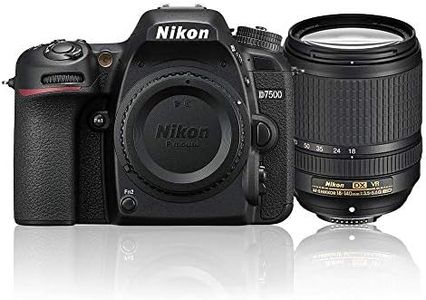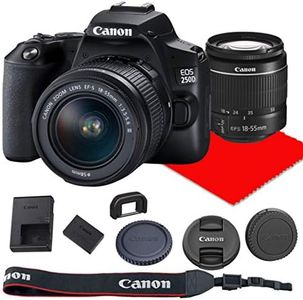We Use CookiesWe use cookies to enhance the security, performance,
functionality and for analytical and promotional activities. By continuing to browse this site you
are agreeing to our privacy policy
5 Best Entry Level Dslr Cameras
From leading brands and best sellers available on the web.Buying Guide for the Best Entry Level Dslr Cameras
Choosing an entry-level DSLR camera can be exciting, especially if you’re new to photography or looking to upgrade from a smartphone or basic point-and-shoot camera. The right camera will help you learn, explore, and enjoy photography comfortably. When making your decision, it’s important to look at a few key features that impact usability and image quality. Focus on what matches your interests and how you plan to use the camera, whether that’s for travel, family events, or creative projects.Sensor SizeThe sensor in a DSLR is like the film in old cameras—it captures the light and forms an image. Sensor size is important because a larger sensor generally produces clearer, sharper photos with better performance in low light. Most entry-level DSLRs feature APS-C sensors, which are smaller than full-frame sensors found in professional cameras but still much bigger than those in most phones. If you mainly shoot in bright light or want a lighter camera, an APS-C sensor is perfect and gives excellent image quality for learning and general use. Understanding that larger sensors make the camera and lenses bigger and heavier can help you decide what feels comfortable for you.
MegapixelsMegapixels refer to how many tiny dots (pixels) make up your photos. A higher megapixel count means you can print larger photos or crop images without losing much detail. For most beginners, anything between 16 and 24 megapixels is more than enough for clear pictures, sharing online, or printing out memories. Higher megapixels aren’t always better, as they can lead to larger file sizes and aren’t as crucial unless you plan on making big prints or cropping heavily.
Autofocus SystemThe autofocus system helps your camera lock focus on your subject quickly and accurately. Entry-level DSLRs come with different numbers of autofocus points—these are areas the camera uses to focus. More points can help track moving subjects and make it easier to frame off-center, but even a basic system is fine for most casual shooting. If you want to photograph moving people or animals, look for a camera with more focus points and reliable tracking features.
Continuous Shooting SpeedContinuous shooting speed, or frames per second (fps), tells you how fast the camera can take pictures in a burst. This is very useful if you want to capture action, like kids playing sports or pets running around. Entry-level DSLRs usually offer 3–6 fps. If your focus is everyday photography, a lower fps is sufficient, but for action or sports, look for a camera on the higher end of this range.
Ease of Use and ControlsEntry-level cameras are designed to be simple, but some are more beginner-friendly, with clear menus and guides. Some have touchscreen controls, physical dials, or helpful tutorials built in. Think about how comfortable you feel with technology—if you like 'set it and forget it,' look for a camera with scene modes and on-screen tips. If you want to grow your skills, one with more manual controls may suit you better.
Lens CompatibilityDSLRs use interchangeable lenses, so the camera should be compatible with a good selection of lenses, both from the manufacturer and third-party brands. This impacts how much you can explore and expand your photography in the future. For starting out, most entry-level models come with a general-purpose 'kit lens.' It’s wise to check that you can add affordable lenses for portraits or landscapes as your interest grows.
Size and WeightThe size and weight of a DSLR affect how easy it is to carry around and use, especially when traveling or shooting for long periods. Entry-level models are usually smaller and lighter, making them easy for beginners to handle. If you want a camera you’ll carry everywhere, pay attention to the weight with the lens attached and see how it feels in your hands.
Screen and ViewfinderMany DSLRs have fixed or tilting screens, and some are touch-sensitive, which makes it easier to take photos from different angles or review your shots. The optical viewfinder lets you see the scene without any delay. If you plan on shooting videos or want flexibility when composing shots, a tilting or rotating screen can be very handy. Try out how each feels when taking a picture to see what you prefer.
Video CapabilityIf you want to record video as well as take photos, check the camera’s video features. Most entry-level DSLRs can record in at least Full HD (1080p), which is clear enough for social media and personal use. Some newer models offer 4K recording. If video is a priority, look for features like autofocus during video and a microphone input for better sound.
ConnectivitySharing photos is important to many users, and modern entry-level DSLRs often include built-in Wi-Fi, Bluetooth, or NFC. These let you transfer images wirelessly to your phone or computer and sometimes allow remote control through an app. If you like to share your photos quickly or control your camera from your phone, pay attention to the wireless features.





